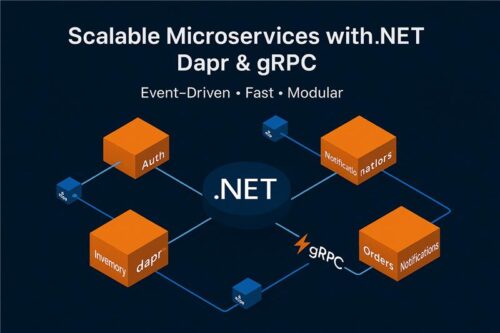
Introduction
In an era where digital agility defines market leadership, enterprises are increasingly adopting microservices architecture to build applications that are scalable, modular, and cloud-native. At 4devnet, we help organizations modernize their software ecosystems using cutting-edge technologies like .NET, Dapr (Distributed Application Runtime), and gRPC—delivering enterprise-grade solutions with unmatched performance and reliability.
This article explores how 4devnet leverages the power of .NET, Dapr, and gRPC to architect next-generation distributed systems that meet the demands of modern business environments.
What Are Microservices?
Microservices refer to a software development strategy where an application is composed of independent, loosely coupled services, each responsible for a specific business capability. Unlike monolithic applications, microservices can be developed, deployed, and scaled independently.
Core Advantages
- Faster deployment cycles.
- Improved scalability and fault isolation.
- Polyglot programming and technology diversity.
- Better alignment with DevOps and CI/CD practices.
Why .NET is Ideal for Microservices
.NET (especially ASP.NET Core) has evolved into a robust, cross-platform framework ideal for microservices-based architectures. With its lightweight runtime, built-in support for dependency injection, and seamless Docker/Kubernetes integration, .NET enables organizations to deliver high-performance services at scale.
At 4devnet, we use .NET to:
- Develop RESTful and gRPC-based services.
- Containerize applications for multi-cloud deployment.
- Enable secure, production-ready APIs with integrated Identity and access controls.
Simplifying Microservices with Dapr
Dapr is a portable, event-driven runtime designed to abstract common microservices complexities such as service discovery, state management, and message-driven communication. By using a sidecar pattern, Dapr offers plug-and-play capabilities to any language or framework—making it a powerful enabler for heterogeneous environments.
How 4devnet Uses Dapr
- Service Discovery: Automatically resolves services without hardcoded endpoints.
- Pub/Sub Messaging: Integrates distributed messaging with tools like Kafka and Redis.
- State Management: Manages key-value storage across cloud-native components.
- Observability: Provides end-to-end tracing and metrics for all services.
By decoupling infrastructure concerns from business logic, Dapr allows our teams to accelerate delivery while maintaining operational excellence.
Enhancing Communication with gRPC
gRPC is a high-performance RPC framework that leverages HTTP/2 and Protocol Buffers to enable fast, efficient communication between services. It is particularly useful for scenarios where low latency and real-time communication are critical.
gRPC at 4devnet
- Utilized in high-throughput APIs and internal service communication.
- Enables bi-directional streaming for real-time data processing.
- Strongly typed contracts reduce integration errors.
gRPC vs REST (Quick Comparison)
| Feature | gRPC | REST |
| Protocol | HTTP/2 + Protobuf | HTTP/1.1 + JSON |
| Speed | Faster | Moderate |
| Streaming | Full Support | Limited |
| Contract Type | Strongly Typed | Schema-less |
Architectural Blueprint: .NET + Dapr + gRPC
At 4devnet, our standard architecture for building modern microservices includes:
- .NET Core Services exposing gRPC APIs.
- Dapr Sidecars for service invocation, messaging, and configuration.
- Redis or Azure Cosmos DB for state and caching.
- Jaeger or Azure Monitor for distributed tracing and observability.
- Docker + Kubernetes for containerized orchestration.
Each service is built independently, containerized, and deployed via CI/CD pipelines—ensuring consistent performance across environments.
Implementation Snapshot: Getting Started with .NET, Dapr & gRPC
Prerequisites
- .NET 8 SDK
- Docker Engine
- Dapr CLI (dapr init)
- Visual Studio / VS Code
Step 1: Create a gRPC Service
bash
CopyEdit
dotnet new grpc -n InventoryService
cd InventoryService
Step 2: Add Dapr Support
bash
CopyEdit
dotnet add package Dapr.Client
Step 3: Enable Cloud Events
In Program.cs:
csharp
CopyEdit
app.UseCloudEvents();
app.MapSubscribeHandler();
Step 4: Run Service with Dapr Sidecar
bash
CopyEdit
dapr run –app-id inventory-service –app-port 5000 — dotnet run.
This launches your microservice with built-in service discovery, observability, and fault resilience—all managed by Dapr.
Best Practices Followed by 4devnet
- Domain-Driven Design (DDD): Services are organized around business capabilities.
- Versioned Protobuf Contracts: Ensures backward compatibility and clean upgrades.
- Sidecar Observability: Distributed tracing via Zipkin or Azure Monitor.
- Resilient Architecture: Dapr’s retries, timeouts, and circuit breakers enable high availability.
- Security by Default: Integration with OAuth2 and role-based access control (RBAC).
Industry Use Cases
- E-Commerce: Real-time inventory sync and recommendation engines.
- Fintech: High-throughput payment gateways using gRPC for performance.
- Healthcare: Modular systems for patient records and clinical workflows.
- Manufacturing: IoT-driven control systems powered by event streaming.
Conclusion
At 4devnet, we believe that the future of software lies in modular, intelligent, and cloud-native systems. By leveraging the power of .NET, Dapr, and gRPC, we enable our clients to build digital platforms that are fast, resilient, and future-proof.
Whether you’re modernizing a legacy monolith or building a new distributed solution from scratch, our architecture-first approach ensures your systems are built to scale with your business.
